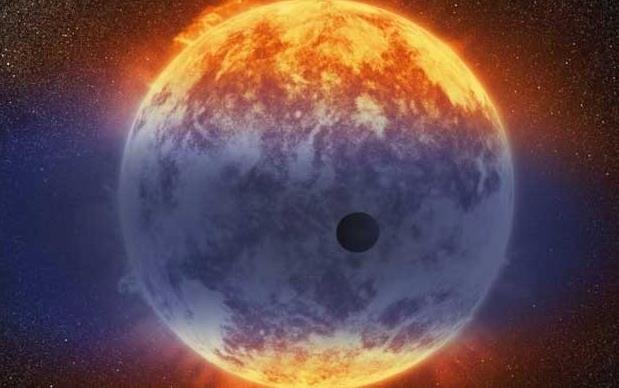Astronomers have witnessed a rare phenomenon of a star ripping apart the atmosphere of a giant exoplanet, creating a massive tail of gas that stretches for millions of miles.
The Explosive Fate of HAT-P-32 b
The exoplanet in question is called HAT-P-32 b, and it is located about 950 light-years away from Earth. It has a mass around 68% that of Jupiter, but is twice as wide as the solar system’s largest planet. This means that HAT-P-32 b is very puffy and has a low density.
HAT-P-32 b orbits very close to its parent star, only 3.2 million miles away, or about 3% of the distance between Earth and the sun. It completes one orbit every 2.2 days. This proximity exposes the exoplanet to intense radiation and heat from the star, making it a so-called “hot Jupiter” planet.
The star’s fury is so strong that it blows away the atmosphere of HAT-P-32 b, creating a huge tail of gas that is one of the largest structures seen around a planet outside of the solar system. The tail is about 53 times the planet’s radius, or about 18 times the size of Jupiter.
“We have monitored this planet and the host star with long time series spectroscopy, observations made of the star and planet over a couple of nights,” said Zhoujian Zhang, a postdoctoral fellow at the University of California Santa Cruz and the lead author of the study. “And what we found is there’s a gigantic helium gas tail that is associated with the planet. The tail is large — about 53 times the planet’s radius — formed by gas that’s escaping from the planet.”

How to Detect a Planet’s Tail
The researchers used telescopes from Earth, including the Hobby-Eberly Telescope of The University of Texas at Austin’s McDonald Observatory, to observe the star and the planet. They focused on the helium absorption line, which is a specific wavelength of light that helium atoms absorb.
When the planet passes in front of the star, some of the starlight passes through the planet’s atmosphere and tail before reaching Earth. This causes a dip in the brightness of the star at the helium absorption line. By measuring this dip, astronomers can estimate how much helium is in the planet’s atmosphere and tail.
The team found that the helium absorption line was very deep and broad, indicating that there was a lot of helium escaping from the planet. They also found that the absorption line varied over time, suggesting that the tail was dynamic and affected by stellar winds and magnetic fields.
“The helium absorption line changes from night to night, which means that there are some processes happening in this system that make it non-stable,” Zhang said. “It could be due to stellar winds or magnetic fields, but we don’t have enough data to confirm that.”
What This Means for Planetary Evolution
The study of HAT-P-32 b and its tail could help astronomers understand how planets evolve over time under extreme conditions. In particular, it could shed light on a puzzling gap in the exoplanet catalog.
Astronomers have discovered thousands of exoplanets in different sizes and orbits, but there seems to be a lack of intermediate-sized planets close to their stars. These planets are called “hot-Neptunes” after the solar system ice giant of a similar size, and their absence is known as the “hot-Neptunian desert.”
One possible explanation for this desert is that hot-Neptunes lose their atmospheres due to stellar radiation and become smaller rocky planets over time. HAT-P-32 b could be an example of this process happening in real time.
“HAT-P-32 b could be an intermediate stage between a hot-Jupiter and a hot-Neptune,” Zhang said. “It could be losing mass so fast that it will become a hot-Neptune in the future.”
The team plans to continue observing HAT-P-32 b and other similar planets to test this hypothesis and learn more about how planets lose their atmospheres.
